Soil Erosion in Taiwan
Abstract
1. Introduction
2. Materials and Methods
2.1. Study Area
2.2. Model and Data
- Rm = rainfall-runoff erosivity factor (MJ mm ha−1 hr−1 year−1);
- Km = soil erodibility factor (Mg hr MJ−1 mm−1);
- L = slope length factor (dimensionless);
- S = slope steepness factor (dimensionless);
- C = cover management factor (dimensionless);
- P = support practice factor (dimensionless).
- D = the grid cell size (m);
- αi,j = aspect direction for the grid cell with coordinates (i,j).
3. Results
3.1. Assessment of Soil Erosion in Taiwan
3.2. Validation with Soil Erosion Pins
3.3. Comparison of Soil Erosion by LS Class
4. Discussion
4.1. Methodological Rigor and Validation
4.2. Limitations of this Study and Future Directions
5. Conclusions
Author Contributions
Funding
Data Availability Statement
Acknowledgments
Conflicts of Interest
References
- Hudson, N. Soil Conservation; B T Batsford Limited: London, UK, 1981; 324p. [Google Scholar]
- Wischmeier, W.H.; Smith, D.D. Predicting Rainfall-Erosion Losses from Cropland East of the Rocky Mountains: Guide for Selection of Practices for Soil and Water Conservation (No. 282); Agricultural Research Service, US Department of Agriculture: Washington, DC, USA, 1965.
- Wischmeier, W.H.; Smith, D.D. Predicting Rainfall Erosion Losses: A Guide to Conservation Planning (No. 537); Department of Agriculture, Science and Education Administration: Washington, DC, USA, 1978.
- Renard, K.G.; Foster, G.R.; Weesies, G.A.; McCool, D.K.; Yoder, D.C. Predicting Soil Erosion by Water: A Guide to Conservation Planning with the Revised Universal Soil Loss Equation (RUSLE), Agricultural Handbook Number 703; United States Department of Agriculture: Washington, DC, USA, 1997.
- Borrelli, P.; Alewell, C.; Alvarez, P.; Anache, J.A.A.; Baartman, J.; Ballabio, C.; Bezak, N.; Biddoccu, M.; Cerdà, A.; Chalise, D.; et al. Soil erosion modelling: A global review and statistical analysis. Sci. Total Environ. 2021, 780, 146494. [Google Scholar] [CrossRef] [PubMed]
- Lo, K.F.A. Quantifying soil erosion for the Shihmen reservoir watershed, Taiwan. Agric. Syst. 1994, 45, 105–116. [Google Scholar] [CrossRef]
- Chen, C.N.; Tsai, C.H.; Tsai, C.T. Simulation of runoff and suspended sediment transport rate in a basin with multiple watersheds. Water Resour. Manag. 2011, 25, 793–816. [Google Scholar] [CrossRef][Green Version]
- Chiu, Y.J.; Chang, K.T.; Chen, Y.C.; Chao, J.H.; Lee, H.Y. Estimation of soil erosion rates in a subtropical mountain watershed using 137Cs radionuclide. Nat. Hazards 2011, 59, 271–284. [Google Scholar] [CrossRef]
- Chen, S.K.; Liu, C.W.; Chen, Y.R. Assessing soil erosion in a terraced paddy field using experimental measurements and universal soil loss equation. Catena 2012, 95, 131–141. [Google Scholar] [CrossRef]
- Wu, C.-H.; Chen, C.-N.; Tsai, C.-H.; Tsai, C.-T. Estimating sediment deposition volume in a reservoir using the physiographic soil erosion-deposition model. Int. J. Sediment Res. 2012, 27, 362–377. [Google Scholar] [CrossRef]
- Chen, S.K.; Chen, Y.R.; Peng, Y.H. Experimental study on soil erosion characteristics in flooded terraced paddy fields. Paddy Water Environ. 2013, 11, 433–444. [Google Scholar] [CrossRef]
- Lin, C.P.; Chen, C.N.; Wang, Y.M.; Tsai, C.H.; Tsai, C.T. Spatial distribution of soil erosion and suspended sediment transport rate for Chou-Shui river basin. J. Earth Syst. Sci. 2014, 123, 1517–1539. [Google Scholar] [CrossRef]
- Jien, S.H.; Lee, M.H.; Hseu, Z.Y.; Wang, H.H. Erosion potential estimation by network measurement of soil properties in coastal areas after clearcutting. Int. J. Distrib. Sens. Netw. 2015, 11, 281321. [Google Scholar] [CrossRef]
- Lin, B.S.; Thomas, K.; Chen, C.K.; Ho, H.C. Evaluation of soil erosion risk for watershed management in Shenmu watershed, central Taiwan using USLE model parameters. Paddy Water Environ. 2016, 14, 19–43. [Google Scholar] [CrossRef]
- Chen, W.; Li, D.H.; Yang, K.J.; Tsai, F.; Seeboonruang, U. Identifying and comparing relatively high soil erosion sites with four DEMs. Ecol. Eng. 2018, 120, 449–463. [Google Scholar] [CrossRef]
- Liu, Y.H.; Li, D.H.; Chen, W.; Lin, B.S.; Seeboonruang, U.; Tsai, F. Soil erosion modeling and comparison using slope units and grid cells in Shihmen reservoir watershed in Northern Taiwan. Water 2018, 10, 1387. [Google Scholar] [CrossRef]
- Nguyen, K.A.; Chen, W.; Lin, B.S.; Seeboonruang, U.; Thomas, K. Predicting sheet and rill erosion of Shihmen reservoir watershed in Taiwan using machine learning. Sustainability 2019, 11, 3615. [Google Scholar] [CrossRef]
- Lu, C.M.; Chiang, L.C. Assessment of sediment transport functions with the modified SWAT-Twn model for a Taiwanese small mountainous watershed. Water 2019, 11, 1749. [Google Scholar] [CrossRef]
- Chen, C.N.; Tfwala, S.S.; Tsai, C.H. Climate change impacts on soil erosion and sediment yield in a watershed. Water 2020, 12, 2247. [Google Scholar] [CrossRef]
- Tsai, F.; Lai, J.S.; Nguyen, K.A.; Chen, W. Determining Cover Management Factor with Remote Sensing and Spatial Analysis for Improving Long-Term Soil Loss Estimation in Watersheds. ISPRS Int. J. Geo-Inf. 2021, 10, 19. [Google Scholar] [CrossRef]
- Nguyen, K.A.; Chen, W.; Lin, B.S.; Seeboonruang, U. Comparison of ensemble machine learning methods for soil erosion pin measurements. ISPRS Int. J. Geo-Inf. 2021, 10, 42. [Google Scholar] [CrossRef]
- Nguyen, K.A.; Chen, W. DEM-and GIS-Based Analysis of Soil Erosion Depth Using Machine Learning. ISPRS Int. J. Geo-Inf. 2021, 10, 452. [Google Scholar] [CrossRef]
- Chiang, L.C.; Liao, C.J.; Lu, C.M.; Wang, Y.C. Applicability of modified SWAT model (SWAT-Twn) on simulation of watershed sediment yields under different land use/cover scenarios in Taiwan. Environ. Monit. Assess. 2021, 193, 250. [Google Scholar] [CrossRef]
- Chen, W.; Wang, W.H.; Nguyen, K.A. Soil Erosion and Deposition in a Taiwanese Watershed Using USPED. Sustainability 2022, 14, 3397. [Google Scholar] [CrossRef]
- Lin, Y.C.; Huang, S.L. Spatial Emergy Synthesis of the Environmental Impacts from Agricultural Production System Change–A Case Study of Taiwan. In Proceedings of the 7th Biennial Emergy Research Conference, Gainesville, FL, USA, 12–14 January 2012. [Google Scholar]
- Brady, N.C.; Weil, R.R.; Weil, R.R. The Nature and Properties of Soils, 15th ed.; Pearson Education Limited: Harlow, UK, 2017. [Google Scholar]
- Lee, M.; Charman, J. Soil Erosion. Geomorphol. Eng. 2005, 1, 287. [Google Scholar]
- Huh, C.A.; Su, C.C. Distribution of fallout radionuclides (7Be, 137Cs, 210Pb and 239,240 Pu) in soils of Taiwan. J. Environ. Radioact. 2004, 77, 87–100. [Google Scholar] [CrossRef] [PubMed]
- Copper, J.C. Taiwan. 2022. Available online: https://www.britannica.com/place/Taiwan (accessed on 20 June 2022).
- Water Resources Agency, MOEA. 2023. Precipitation in Taiwan. Available online: https://eng.wra.gov.tw/cp.aspx?n=5121 (accessed on 13 September 2023).
- Huang, S.C.; Huang, W.R.; Wu, Y.C.; Yu, Y.C.; Chu, J.L.; Jou, B.J.D. Characteristics and causes of Taiwan’s extreme rainfall in 2022 January and February. Weather. Clim. Extrem. 2022, 38, 100532. [Google Scholar] [CrossRef]
- Lien, T.Y.; Yeh, T.K.; Hong, J.S.; Hsiao, T.Y. Variations in GPS precipitable water vapor and rainfall during the 2006–2019 Mei-yu season in Taiwan. Adv. Space Res. 2022, 70, 1375–1387. [Google Scholar] [CrossRef]
- Hseu, Z.-Y.; Tsai, C.-C.; Chen, Z.-S. Soil, Science under the Soles of the Feet; Wu-Nan Publishing: Wuhan, Chian, 2017; 206p. (In Chinese) [Google Scholar]
- Hseu, Z.-Y. Taiwan Soil Classification. Available online: http://teacher.ac.ntu.edu.tw/zh_tw/Zhengyi/SoilSurveyClassification/Taiwansoilclassification (accessed on 18 September 2023). (In Chinese).
- Lu, J.-Y.; Su, C.-C.; Wu, I.-Y. Revision of the isoerodent map for the Taiwan area. J. Chin. Soil Water Conserv. 2005, 36, 159–172. (In Chinese) [Google Scholar]
- Wann, S.-S.; Hwang, J.-I. Soil erosion on hillslopes of Taiwan. J. Chin. Soil Water Conserv. 1989, 20, 17–45. (In Chinese) [Google Scholar]
- Foster, G.R.; Wischmeier, W. Evaluating irregular slopes for soil loss prediction. Trans. ASAE 1974, 17, 305–309. [Google Scholar] [CrossRef]
- Desmet, P.J.J.; Govers, G. A GIS procedure for automatically calculating the USLE LS factor on topographically complex landscape units. J. Soil Water Conserv. 1996, 51, 427–433. [Google Scholar]
- Conrad, O.; Bechtel, B.; Bock, M.; Dietrich, H.; Fischer, E.; Gerlitz, L.; Wehberg, J.; Wichmann, V.; Boehner, J. System for Automated Geoscientific Analyses (SAGA) v. 2.1.4. Geosci. Model. Dev. 2015, 8, 1991–2007. [Google Scholar] [CrossRef]
- Panagos, P.; Borrelli, P.; Meusburger, K. A new European slope length and steepness factor (LS-factor) for modeling soil erosion by water. Geosciences 2015, 5, 117–126. [Google Scholar] [CrossRef]
- Chen, W.; Nguyen, K.A. The New Island-Wide LS Factors of Taiwan, with Comparison with EU Nations. Sustainability 2022, 14, 3059. [Google Scholar] [CrossRef]
- The European Space Agency. MultiSpectral Instrument (MSI) Overview, Sentinel Online. Available online: https://sentinel.esa.int/web/sentinel/technical-guides/sentinel-2-msi/msi-instrument (accessed on 22 June 2022).
- Gorelick, N.; Hancher, M.; Dixon, M.; Ilyushchenko, S.; Thau, D.; Moore, R. Google Earth Engine: Planetary-scale geospatial analysis for everyone. Remote Sens. Environ. 2017, 202, 18–27. [Google Scholar] [CrossRef]
- The European Space Agency. Overview, Sentinel Online. Available online: https://sentinel.esa.int/web/sentinel/missions/sentinel-2/overview (accessed on 22 June 2022).
- Lin, W.T.; Lin, C.Y.; Chou, W.C. Assessment of vegetation recovery and soil erosion at landslides caused by a catastrophic earthquake: A case study in Central Taiwan. Ecol. Eng. 2006, 28, 79–89. [Google Scholar] [CrossRef]
- Lin, W.T.; Chou, W.C.; Lin, C.Y. Earthquake-induced landslide hazard and vegetation recovery assessment using remotely sensed data and a neural network-based classifier: A case study in central Taiwan. Nat. Hazards 2008, 47, 331–347. [Google Scholar] [CrossRef]
- Chou, W.C.; Lin, W.T.; Lin, C.Y. Vegetation recovery patterns assessment at landslides caused by catastrophic earthquake: A case study in central Taiwan. Environ. Monit. Assess. 2009, 152, 245–257. [Google Scholar] [CrossRef]
- Li, X.; Gong, P.; Zhou, Y.; Wang, J.; Bai, Y.; Chen, B.; Hu, T.; Xiao, Y.; Xu, B.; Yang, J.; et al. Mapping global urban boundaries from the global artificial impervious area (GAIA) data. Environ. Res. Lett. 2020, 15, 094044. [Google Scholar] [CrossRef]
- Lin, W.-C. A Study on Soil Erosion and Influential Hydrologic and Geographic Factors for Shihmen Reservoir Watershed. Master’s Thesis, Tamkang University, New Taipei City, Taiwan, 2014. (In Chinese). [Google Scholar]
- Sinotech Engineering Consultants Inc. Evaluation on Remediation Effectiveness of Conservation and Management for Shihmen Reservoir Watershed in 2015, Soil and Water Conservation Bureau (SWCB) Research Report; Council of Agriculture, Executive Yuan, Taiwan ROC: Taipei, Taiwan, 2015. (In Chinese)
- Lee, C.-Y.; Fu, K.-L.; Tsai, M.-F.; Chien, Y.-D.; Hsu, C.-K.; Lin, B.-S. Application of Erosion Pins Measurement Data to Evaluate Soil Erosion Suppression Rate in Tsengwen Reservoir Watershed. Sinotech Eng. 2015, 129, 9–18. (In Chinese) [Google Scholar]
- Sinotech Engineering Consultants Inc. Multi-Scale Monitoring Investigation and Change Analysis of Large-Scale Sediment Areas, Midterm Report, Soil and Water Conservation Bureau (SWCB) Research Report; Council of Agriculture, Executive Yuan, Taiwan ROC: Taipei, Taiwan, 2017. (In Chinese)
- Panagos, P.; Borrelli, P.; Poesen, J.; Ballabio, C.; Lugato, E.; Meusburger, K.; Montanarella, L.; Alewell, C. The new assessment of soil loss by water erosion in Europe. Environ. Sci. Policy 2015, 54, 438–447. [Google Scholar] [CrossRef]
- Hart, E.A.; Mills, H.H.; Li, P. Measuring erosion rates on exposed limestone residuum using erosion pins: A 10-year record. Phys. Geogr. 2017, 38, 541–555. [Google Scholar] [CrossRef]
- Simplício, A.A.; Costa, C.A.; Navarro-Hevia, J.; de Araújo, J.C. Erosion at hillslope and micro-basin scales in the Gilbués desertification region, Northeastern Brazil. Land Degrad. Dev. 2021, 32, 1487–1499. [Google Scholar] [CrossRef]
- Aburto, F.; Cartes, E.; Mardones, O.; Rubilar, R. Hillslope soil erosion and mobility in pine plantations and native deciduous forest in the coastal range of south-central Chile. Land Degrad. Dev. 2021, 32, 453–466. [Google Scholar] [CrossRef]
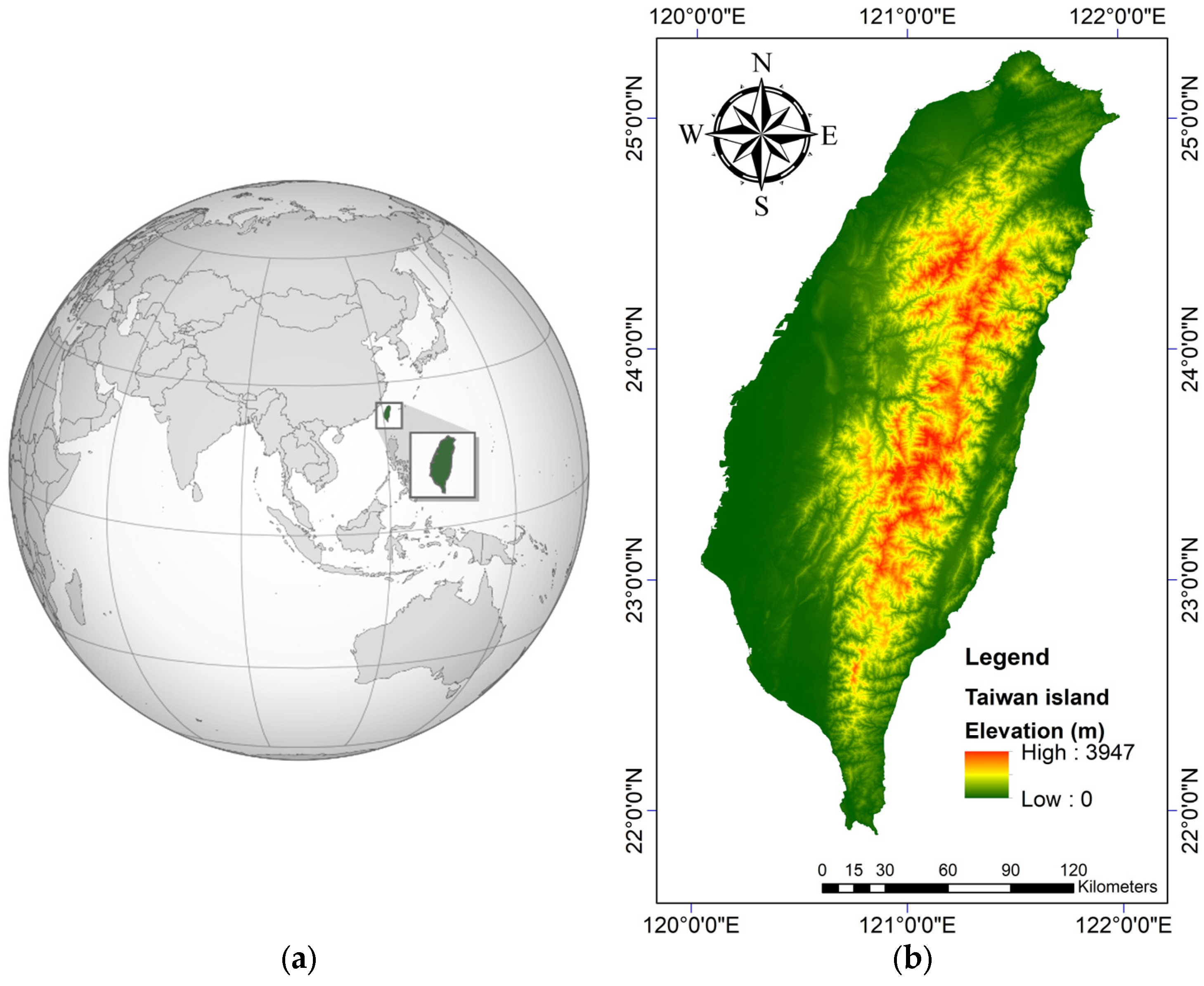
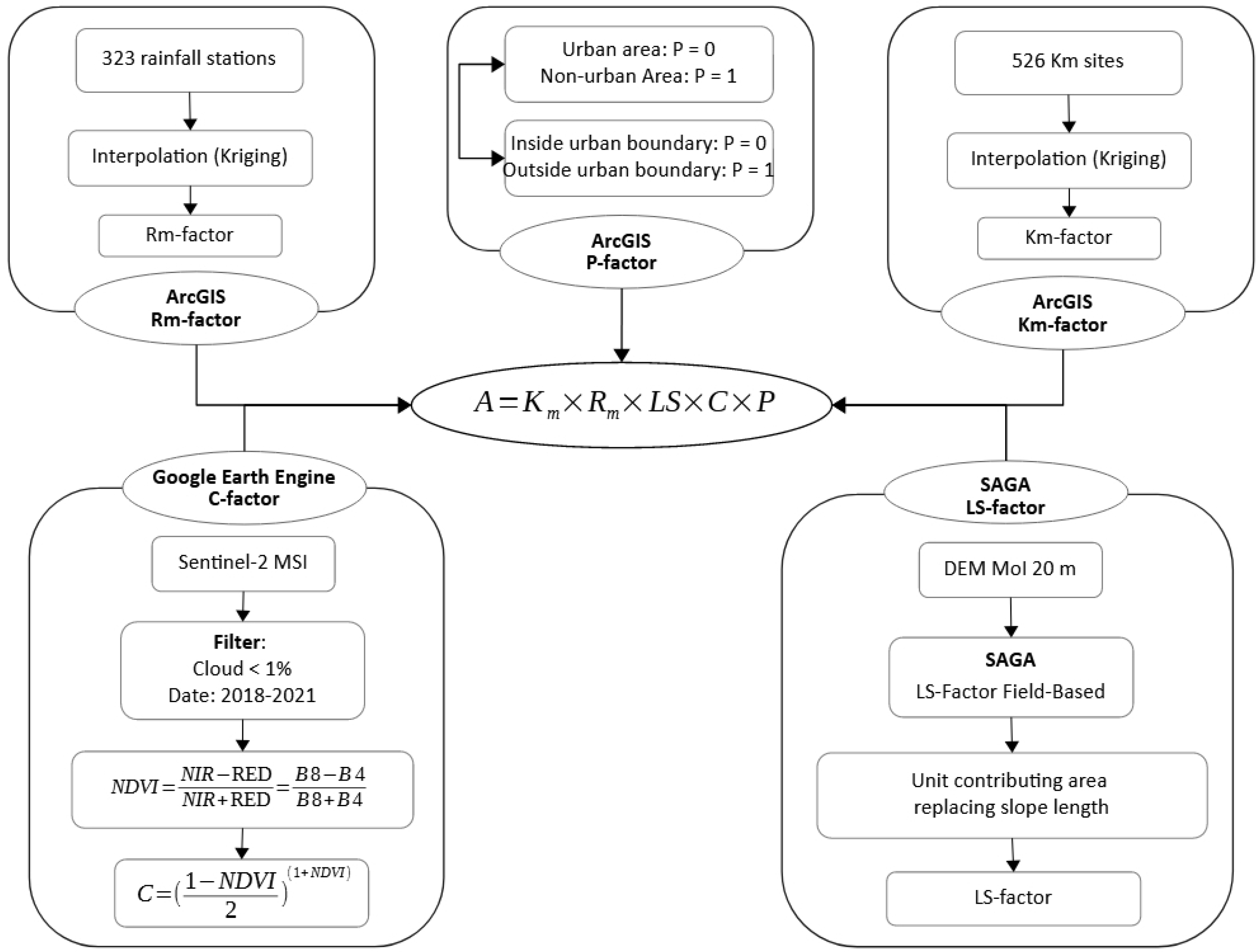
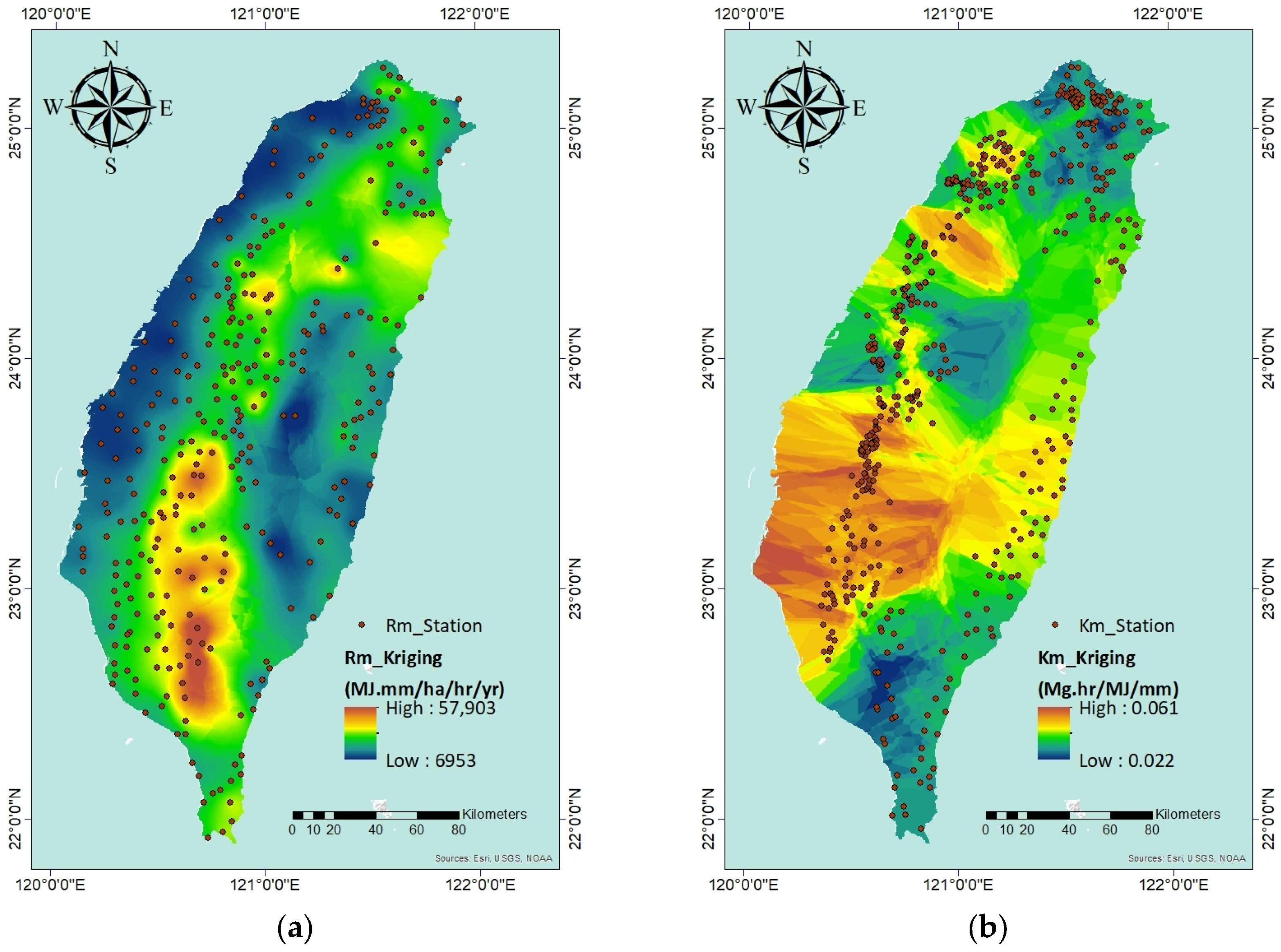
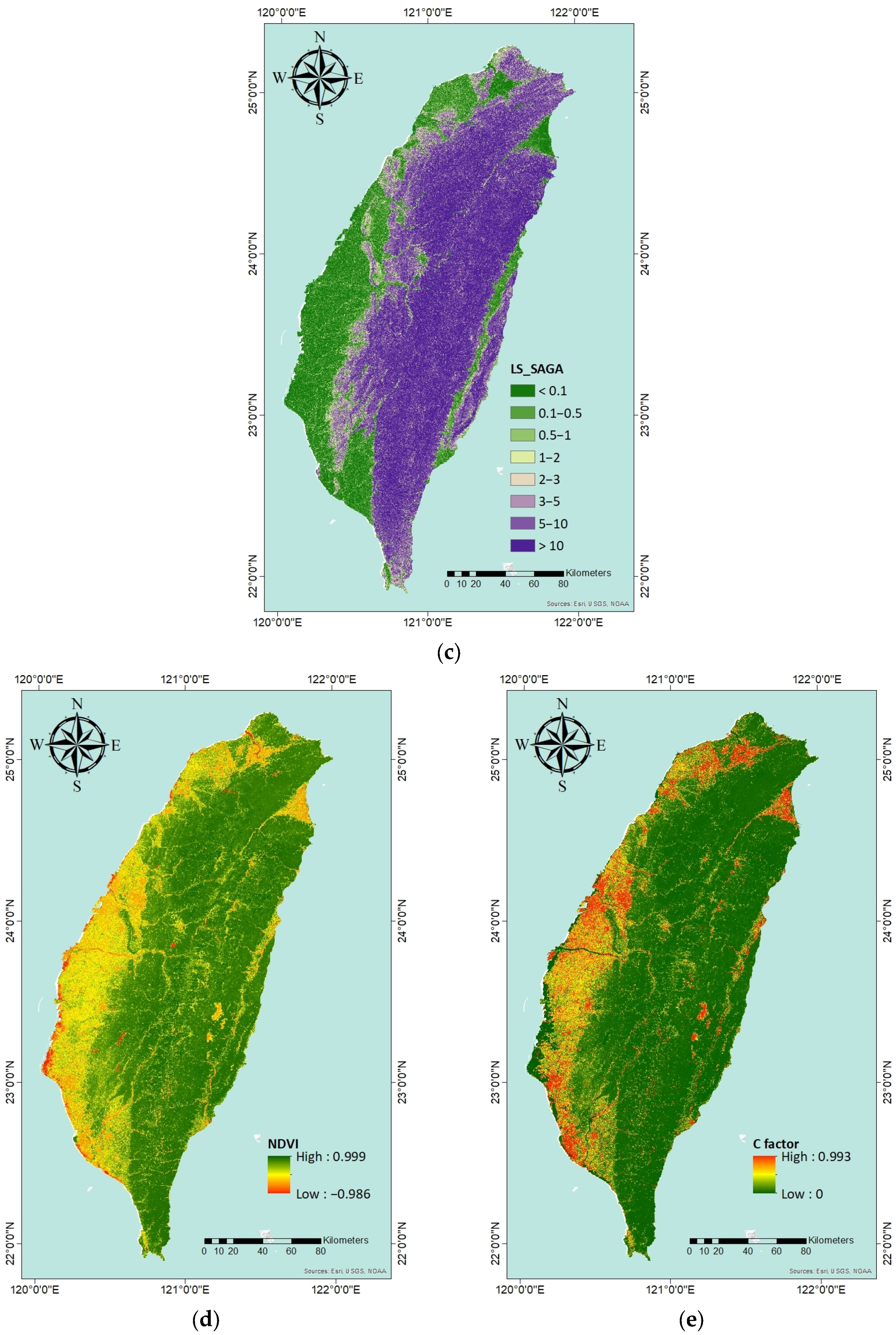


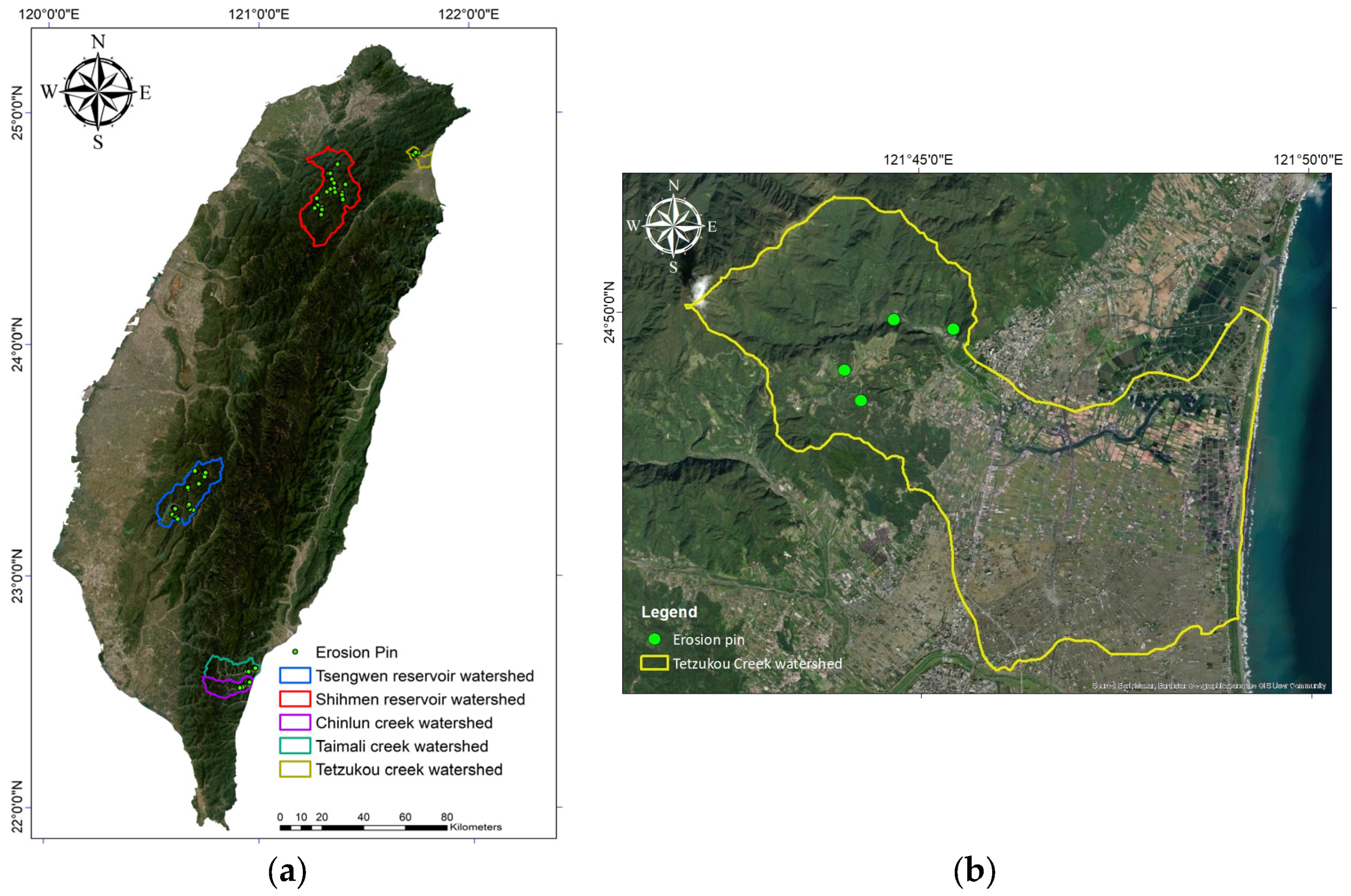

| Year | 2018 | 2019 | 2020 | 2021 |
|---|---|---|---|---|
| Number of visits in the year | 2 | 72 | 75 | 66 |
| Number of visits selected (cloud < 1%) | 0 | 7 | 8 | 9 |
| Dates of the visits used (number of images) | 20190131 (1) | 20200121 (2) | 20210115 (9) | |
| 20190312 (3) | 20200131 (1) | 20210130 (4) | ||
| 20191028 (2) | 20200210 (2) | 20210204 (2) | ||
| 20191112 (3) | 20200225 (2) | 20210316 (5) | ||
| 20191117 (3) | 20200301 (3) | 20210405 (1) | ||
| 20191212 (2) | 20200813 (1) | 20210709 (3) | ||
| 20191222 (2) | 20201002 (2) | 20210828 (1) | ||
| 20201111 (2) | 20211002 (1) | |||
| 20211111 (6) |
| Watershed | Average Erosion Depth Measured by Erosion Pins (mm Year−1) | Period of Measurement | Equivalent Erosion Rate (Mg ha−1 Year−1) | RUSLE (GUB) (Mg ha−1 Year−1) | Prediction Ratio (Predicted/Measured) |
|---|---|---|---|---|---|
| Shihmen reservoir [49] | 6.47 (6.65) | September 2008 to October 2011 | 90.6 (93.1) | 169.9 | 1.88(1.82) |
| Shihmen reservoir [50] | 9.80 (9.93) | April 2015 to August 2015 | 137.2 (139.0) | 169.9 | 1.24 (1.22) |
| Shihmen reservoir [50] | 7.72 (7.86) | September 2008 to October 2011 and April 2015 to August 2015 | 108.1 (110.0) | 169.9 | 1.57 (1.54) |
| Tsengwen reservoir [51] | 23.10 (22.78) | May 2011 to September 2013 (883 days) | 323.4 (318.9) | 331.5 | 1.03 (1.04) |
| Tetzukou creek [52] | 15.53 (15.80) | 3 May 2017 to 7 July 2017 (67 days) | 217.4 (221.2) | 51.9 | 0.24 (0.23) |
| Taimali creek [52] | 23.02 (24.21) | 3 May 2017 to 7 July 2017 (67 days) | 322.3 (338.9) | 405.5 | 1.26 (1.20) |
| Chinlun creek [52] | 20.70 (21.82) | 3 May 2017 to 7 July 2017 (67 days) | 289.8 (305.5) | 414.8 | 1.43 (1.36) |
| LS Class | Rm | Km | C | World Urban Areas | Global Urban Boundaries | ||
|---|---|---|---|---|---|---|---|
| P | Soil Erosion (Mg ha−1 Year−1) | P | Soil Erosion (Mg ha−1 Year−1) | ||||
| <0.1 | 18,056.9 | 0.0434 | 0.200 | 0.271 | 1.1 | 0.745 | 3.8 |
| 0.1–0.5 | 18,713.3 | 0.0422 | 0.186 | 0.373 | 14.2 | 0.752 | 30.5 |
| 0.5–1 | 19,907.3 | 0.0416 | 0.134 | 0.571 | 36.8 | 0.845 | 56.0 |
| 1–2 | 21,453.4 | 0.0410 | 0.090 | 0.721 | 67.0 | 0.924 | 91.0 |
| 2–3 | 22,506.5 | 0.0406 | 0.058 | 0.820 | 91.3 | 0.963 | 113.3 |
| 3–5 | 23,443.1 | 0.0401 | 0.035 | 0.897 | 109.9 | 0.985 | 112.7 |
| 5–10 | 24,432.6 | 0.0398 | 0.020 | 0.966 | 145.6 | 0.997 | 150.0 |
| >10 | 24,455.7 | 0.0400 | 0.024 | 0.996 | 479.6 | 1.000 | 480.7 |
Disclaimer/Publisher’s Note: The statements, opinions and data contained in all publications are solely those of the individual author(s) and contributor(s) and not of MDPI and/or the editor(s). MDPI and/or the editor(s) disclaim responsibility for any injury to people or property resulting from any ideas, methods, instructions or products referred to in the content. |
© 2023 by the authors. Licensee MDPI, Basel, Switzerland. This article is an open access article distributed under the terms and conditions of the Creative Commons Attribution (CC BY) license (https://creativecommons.org/licenses/by/4.0/).
Share and Cite
Chen, W.; Nguyen, K.A.; Huang, Y.-C. Soil Erosion in Taiwan. Agriculture 2023, 13, 1945. https://doi.org/10.3390/agriculture13101945
Chen W, Nguyen KA, Huang Y-C. Soil Erosion in Taiwan. Agriculture. 2023; 13(10):1945. https://doi.org/10.3390/agriculture13101945
Chicago/Turabian StyleChen, Walter, Kieu Anh Nguyen, and Yu-Chieh Huang. 2023. "Soil Erosion in Taiwan" Agriculture 13, no. 10: 1945. https://doi.org/10.3390/agriculture13101945
APA StyleChen, W., Nguyen, K. A., & Huang, Y.-C. (2023). Soil Erosion in Taiwan. Agriculture, 13(10), 1945. https://doi.org/10.3390/agriculture13101945








